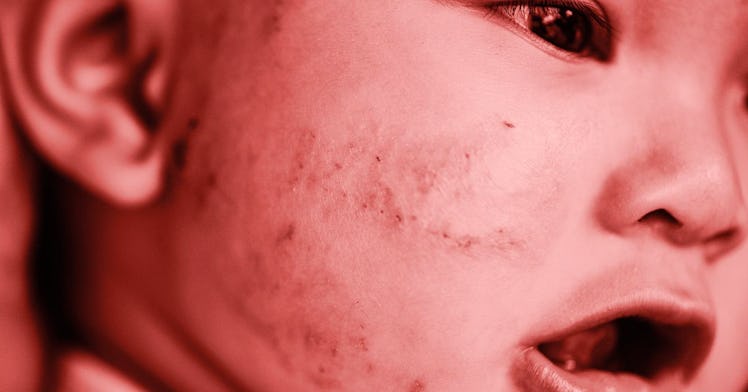How to Tell Heat Rash on Your Baby’s Face from Other Skin Conditions
Parents have a tendency to misdiagnose heat rash. Here's what it might really be.

Touches, cuddles and diaper changes keep parents hyper-focused on the look and feel of a baby’s skin. So, changes in skin condition can be particularly troubling for new moms and dads. That’s particularly true for a condition like baby heat rash which can often take the blame for red irritated skin. But heat rash on a baby’s back, neck, or face is actually pretty rare. What parents might believe to be baby heat rash, is more than likely due to other causes that change the method of treatment substantially.
“When parents come into my office and tell me their baby has a heat rash, that basically means it can be anything,” says Karan Lal, Dermatologist at UMass Memorial Medical Center and member of the Society for Pediatric Dermatology. He notes that what parents think are heat rashes usually amounts to persistent skin irritation that can’t be solved through at-home remedies. But typically those rashes aren’t true heat rash, known medically as miliaria.
There are three different types of miliaria, each defined by the depth of the heat rash. The deepest form of heat rash presents itself as pimple-like bumps across an area of skin that has become hot by being covered by clothing or diapers. Lal points out that the more superficial forms of heat rash look more like dew drops on a baby’s skin. “That’s more common super early in life and is not as red and angry as the typical heat rash that people think about,” he says.
The more angry and concerning rashes are less likely to be specifically related to heat. Instead, most rashes involve issues like eczema and irritant contact dermatitis from frequent stools, frequent urination, or baby wipes.
Another type of rash misdiagnosed as baby heat rash by parents is called intertrigo. These rashes are generally inflamed patches in areas where the skin is folded against itself or hidden. Intertrigo can be caused either by bacteria or yeast. They are easily treated when diagnosed correctly.
Prior to a trip to the doctor, Lal notes that there are ways parents can manage baby skin issue before they get out of hand. He recommends parents keep on top of skin issues through a careful management of clothing and temperature.
- Make sure the skin has adequate airflow by making sure clothes aren’t too tight:“You can always add more layers,” Dr. Lal says. “Pick clothing that is light.”
- Choose fabric that manages moisture: “Moisture puts babies at risk for yeast infections,” Lal offers.
- Avoid oily or heavy moisture barriers: Lal notes that adding thick ointments under heavy clothing is often to blame for heat rashes. He says parents should use lighter moisturizers.
- Let the Baby be Naked: Dr. Lal notes that in other cultures babies have a tendency to remain unclothed which makes their skin exceptionally healthy. American babies spend less time naked and so there are greater chances for heat rashes and yeast infections. A little nudity helps the skin grow healthy bacterial protection while keeping it dry and cool.
But sometimes, skin issues can arise even with the most thoughtful care. That’s totally normal. Dr. Lal notes that parents shouldn’t hesitate to bring a baby to a pediatrician or pediatric dermatologist if they are concerned about a rash on their child’s skin — particularly if the rash, heat or otherwise, can’t be managed at home.
This article was originally published on